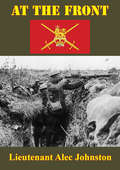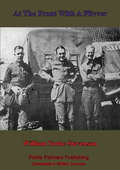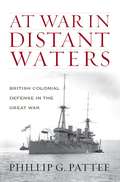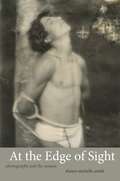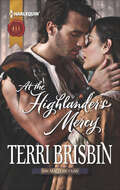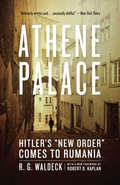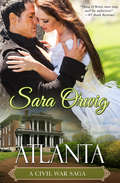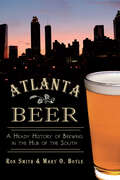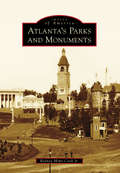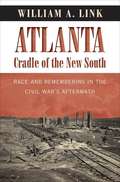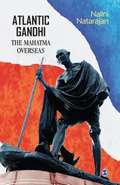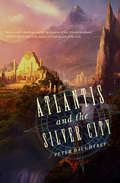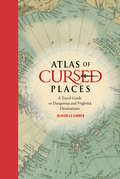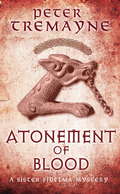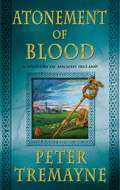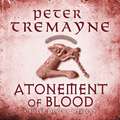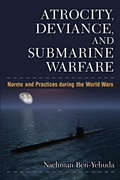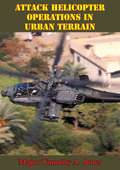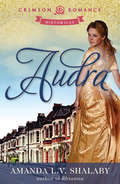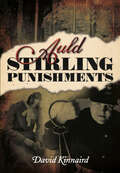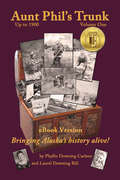- Table View
- List View
At The Front
by Lieutenant Alec JohnstonTHE purpose of this little volume is to preserve, for his friends and the many others who cared for his writings, a record of the work which Alec Johnston contributed to Punch during the War. Written under all sorts of impossible conditions, they never pretended to be more than the gay and cynical banter of one who brought to the hardships and perils of life at the Front an incurable habit of humour. For several years Alec Johnston had been associated with Punch as an occasional contributor of light verse and prose. After leaving Oxford where, as at St. Paul's School, he had given promise of a brilliant career, he became a schoolmaster, but his inclinations lay elsewhere and he would probably have followed the profession of letters but for the outbreak of war. Within two days he enlisted in the Artists' Rifles-he was then twenty-five years old-and went out with their first draft in October, 1914. In February of the next year he received a commission in the 1st King's Shropshire Light Infantry, and was with them first at Armentières, and then upon the Ypres salient till his death. He was promoted Lieutenant in September, 1915.
At The Front In A Flivver [Illustrated Edition]
by William Yorke StevensonMany American citizens flocked to join the Allied war effort against Germany during the First World War before their mother country eventually declared war in 1917. William Yorke Stevenson was one of their number, volunteering for service with the French Ambulance corps or Section Sanitaire. Never war from the frontlines in rather ramshackle old vehicles [the flivver of the title is a slang term for a run-down truck], these men risked their lives to evacuate and treat the wounded.The Author recounts his experiences of 1915-1917 based on his dairy of the period. It provides a day-by-day account of the medical services behind the lines during some of the heaviest French fighting of the war during the battle of the Somme. Illustrated throughout with the Author's own photos of the period, including his comrades, conditions and the battle damage of the towns and villages amongst which he worked and lived.Author -- William Yorke Stevenson (1878 - 1922)Text taken, whole and complete, from the edition published in Boston and New York, Houghton Miflin, 1917.Original Page Count - 334 pages.Illustrations -- 12 illustrations.
At War in Distant Waters
by Phillip G. PatteeA Great and Urgent Imperial Service investigates the reasons behind Great Britain's combined military and naval offensive expeditions of Europe during the Great War. These campaigns have been branded by various historians as unnecessary sideshows to the conflict waged on the European continent. Pattee argues that the various campaigns were necessary adjuncts to the war in Europe, and fulfilled an important strategic purpose by protecting British trade where it was most vulnerable. Since international trade was essential for maintaining the island nation's way of life, Great Britain required freedom of the seas in order to maintain its global trade. While the German High Seas Fleet constituted a serious threat that placed the British coast at grave risk, forcing the Royal Navy to concentrate in home waters, the importance of the island empire's global trade made it a valuable and vulnerable target to Germany's various commerce raiders-as Admiral Tirpitz's risk theory had anticipated.
At the Edge of Sight: Photography and the Unseen
by Shawn Michelle SmithThe advent of photography revolutionized perception, making visible what was once impossible to see with the human eye. In At the Edge of Sight, Shawn Michelle Smith engages these dynamics of seeing and not seeing, focusing attention as much on absence as presence, on the invisible as the visible. Exploring the limits of photography and vision, she asks: What fails to register photographically, and what remains beyond the frame? What is hidden by design, and what is obscured by cultural blindness? Smith studies manifestations of photography's brush with the unseen in her own photographic work and across the wide-ranging images of early American photographers, including F. Holland Day, Eadweard Muybridge, Andrew J. Russell, Chansonetta Stanley Emmons, and Augustus Washington. She concludes by showing how concerns raised in the nineteenth century remain pertinent today in the photographs of Abu Ghraib. Ultimately, Smith explores the capacity of photography to reveal what remains beyond the edge of sight.
At the Highlander's Mercy: The Highlander's Stolen Touch At The Highlander's Mercy The Highlander's Dangerous Temptation Yield To The Highlander (The MacLerie Clan)
by Terri BrisbinA clan chief’s desperate plan to reunite his people may also rekindle an unforgettable passion in this medieval Scottish romance.To regain control of his fractured clan, Robert Matheson needs bargaining power. Taking Lilidh MacLerie hostage should give him plenty. But Lilidh is no ordinary captive. She’s the woman he once loved—and rejected!Rob’s touch is etched permanently into Lilidh’s memory. Unaware that he was forced to repudiate their love, she has never forgotten the man who broke her heart all those years ago. Now, looking into the eyes of her captor, she no longer recognizes this fearsome leader. She should be afraid—there’s no telling what he will do. But something about him excites and unnerves her in equal measure . . . .
Athene Palace: Hitler's "New Order" Comes to Rumania
by R.G. WaldeckOn the day that Paris fell to the Nazis, R. G. Waldeck was checking into the swankiest hotel in Bucharest, the Athene Palace. A cosmopolitan center during the war, the hotel was populated by Italian and German oilmen hoping to secure new business opportunities in Romania, international spies cloaked in fake identities, and Nazi officers whom Waldeck discovered to be intelligent but utterly bloodless. A German Jew and a reporter for Newsweek, Waldeck became a close observer of the Nazi invasion. As King Carol first tried to placate the Nazis, then abdicated the throne in favor of his son, Waldeck was dressing for dinners with diplomats and cozying up to Nazi officers to get insight and information. From her unique vantage, she watched as Romania, a country with a pro-totalitarian elite and a deep strain of anti-Semitism, suffered civil unrest, a German invasion, and an earthquake, before turning against the Nazis. A striking combination of social intimacy and disinterest political analysis, Athene Palace evokes the elegance and excitement of the dynamic international community in Bucharest before the world had comes to grips with the horrors of war and genocide. Waldeck’s account strikingly presents the finely wrought surface of dinner parties, polite discourse, and charisma, while recognizing the undercurrents of violence and greed that ran through the denizens of Athene Palace.
Athens, Thrace, and the Shaping of Athenian Leadership
by Matthew A. SearsFrom the mid-sixth to the mid-fourth century BCE a nexus of connections to Thrace defined the careers of several of Athens' most prominent figures, including Pisistratus, Miltiades, Alcibiades, and Iphicrates. This book explores the importance of Thrace to these individuals and its resulting significance in the political, cultural, and social history of Athens. Thrace was vitally important for Athens thanks to its natural resources and access to strategic waterways, which were essential to a maritime empire, and connections to the area conferred wealth and military influence on certain Athenians and offered them a refuge if they faced political persecution at home. However, Thrace's importance to prominent individuals transcended politics: its culture was also an important draw. Thrace was a world free of Athenian political, social, and cultural constraints - one that bore a striking resemblance to the world of Homeric epic.
Atlanta (The Civil War Saga #3)
by Sara OrwigThe conclusion to the USA Today–bestselling author&’s sweeping historical romance trilogy is &“a page-turner&” (Romantic Times). The Northern soldiers ravaged Atlanta during the Civil War. Now as the city attempts to recover, all Claire Dryden has left is the little boy she has adopted and sworn to protect with her life. When the handsome Yankee colonel Fortune O&’Brien storms into town demanding to reclaim the boy he claims is his stolen son, Claire&’s vow is put to the test. For she loves the boy more than life itself, but the passion O&’Brien ignites in her threatens to weaken her resolve . . . With Atlanta, the author of New Orleans and Memphis completes this trilogy of passionate love stories set against the dramatic backdrop of the Civil War. &“Fast-paced action and escalating romantic tension . . . These O&’Brien men may well be addictive!&” —Romantic Times &“A wonderful romance told with passion and style . . . Well-developed characters . . . This book is HOT.&” —Affaire de Coeur
Atlanta Beer: A Heady History of Brewing in the Hub of the South (American Palate Ser.)
by Ron Smith Mary O. Boyle&“Delve[s] into a colorful past . . . Stories of early taverns and saloons, religious zeal, prohibition and the roots of the current craft beer boom.&” —Atlanta Journal Constitution Atlanta is a unique southern city known for its vast diversity and fast-paced lifestyle. Rarely is it associated with a rich beer and brewing culture, but not for a lack of one. From Atlanta&’s first brewery in the 1850s to the city&’s Saloon Row and the parched days of local and national Prohibition, the earliest days of Atlanta&’s beer history are laced with scandal and excitement. Follow the journey of beer through Atlanta&’s development, starting with colonial Georgia and the budding wilderness settlement of Terminus and eventually evolving into the ever-growing metropolis known as Atlanta. Authors Ron Smith and Mary Boyle celebrate the resurgence of craft beer in a town that once burned to the ground. As Atlanta rose from the ashes of the Civil War, so also has artisanal beer made a comeback in this enigmatic but resilient city. &“The brewery sections draw attention to some long-neglected businesses . . . But the chapter on Prohibition may be the most fascinating part of the book.&” —American Breweriana Journal &“A fascinating read for any craft beer lover in the Southeast. The book features chapters on frontier taverns of the area, Atlanta&’s first beer boom, stories of early breweries of the city, the brewpub trend and the rise of current breweries located in Georgia&’s capital.&” —Owen Ogletree&’s Brewtopia Brewsletter
Atlanta's Parks and Monuments
by Rodney Mims Cook Jr.Since the city's beginnings after the War of 1812, Atlanta has had a tradition of building with a regard for becoming a world-class metropolis. Before being burned by Union general William T. Sherman in 1864, the city's appearance was described by noted European architect and urban planner Leon Krier as "looking like London in the 18th century." Atlanta was surrounded by estates and plantations, and many of the plantation builders were influenced by Greek and Roman architecture. The argument of slavery to the contrary, builders saw Greek temples as symbols of democracy and, as a result, embraced Greek and Roman revival architecture as the dominant national style. Great monuments followed in this tradition to the letter in the capital of the South.
Atlanta, Cradle of the New South
by William A. LinkAfter conquering Atlanta in the summer of 1864 and occupying it for two months, Union forces laid waste to the city in November. William T. Sherman's invasion was a pivotal moment in the history of the South and Atlanta's rebuilding over the following fifty years came to represent the contested meaning of the Civil War itself. The war's aftermath brought contentious transition from Old South to New for whites and African Americans alike. Historian William Link argues that this struggle defined the broader meaning of the Civil War in the modern South, with no place embodying the region's past and future more clearly than Atlanta. Link frames the city as both exceptional--because of the incredible impact of the war there and the city's phoenix-like postwar rise--and as a model for other southern cities. He shows how, in spite of the violent reimposition of white supremacy, freedpeople in Atlanta built a cultural, economic, and political center that helped to define black America.
Atlantic Gandhi
by Nalini NatarajanUsing the frames of diaspora theory, post-colonial discourse theory and the recent Atlantic turn in studies of resistance, this book brings into relief Gandhi's experience as a traveler moving from a classic colony, India, to the plantation and mining society of South Africa. The author forwards the argument that this move between different modes of production brought Gandhi into contact with indentured laborers, with whom he shared exilic and diasporic consciousness, and whose difficult yet resilient lives inspired his philosophy. It reads Gandhi's nationalistic (that is, anti-colonial) sentiments as born in diasporic exile, where he formed his perspective as a provincial subject in a multiracial plantation. The author's viewpoint has been inspired by the new analytic that has emerged in the last few decades: the Atlantic as an ocean that not just transported the victims of a greedy plantation system, but also saw the ferment of revolutionary ideas. Advance Praise Learned and insightful, Nalini Natarajan, has written an amazing study of Gandhi which shows how transnational, planetary forces from the Caribbean, South Africa, and India were brought to bear on his concept of Indianness. His reading of Thoreau, Ruskin, and Tolstoy helped him form his conception of India as frugal, vegetarian, spiritual, adhering to ahimsa and satyagraha, and a style of anti-modernism which would lead to a very modern struggle of independence on the one hand but separation from the struggles of Zulu in Africa and blacks in Guyana on the other hand. Call them coolie, subaltern, or proletarian, Gandhi's construction of the idea of "India" arose in relation to, but not identity with, the workers of the barracks, the cane field, and the gold mine who produce in war, drugs, and money the defining experiences of modernity. Few will be able to read this book without serious reconsideration of Gandhi's cultural politics and political philosophy. Here is an oceanic Gandhi. Peter Linebaugh author of London Hanged Crime and Civil Society in the Eighteenth Century (1991) and co-author of The Many-Headed Hydra: Sailors, Slaves, Commoners and the Hidden History of the Revolutionary Atlantic (2001) with Marcus Rediker In Atlantic Gandhi: The Mahatma Overseas, Nalini Natarajan places the "coolie woman" in South Africa under the microscope of Gandhian lens against the parallel discourses on their questionable sexuality and value as a labour resource in other sites of Indian indentured labour, including the Caribbean. In doing so she moves us towards a current and more comparative rethinking of the historical clichés that have typified the study of diasporic Indian gender relations under the colonial enterprise. Patricia Mohammed, Professor of Gender and Cultural Studies, University of the West Indies, St Augustine, Caribbean gender studies historian and maker of the award winning film Coolie Pink and Green
Atlantis and the Silver City
by Peter DaughtreyHistory's most intriguing mystery may have been solved--recently unearthed evidence points towards the real location of the ancient, lost city of Atlantis. More than 2,000 years ago Plato laid down around a hundred cryptic clues about the location of the lost world of Atlantis. Since then countless experts have tried to crack Plato's code. Some claim Atlantis lies under the volcanic rocks of Santorini. Others place it in the Bermuda Triangle, off the coast of Africa, or say it is lost forever beneath the waves of the Atlantic Ocean. But what if Atlantis is far closer than we think? What if we can walk its cobble stoned streets today? After a forensic twenty-year examination of Plato's writings, Peter Daughtrey says we can do just that. Having matched an unprecedented number of Plato's clues, Daughtrey outlines the full reach of the ancient empire--and pinpoints the exact location of its once glittering capital city. His quest for the truth about Atlantis runs from the dusty stone quarries of Portugal and the hieroglyphs of Egyptian temples to the newly refurbished museums of Baghdad. It includes the discovery of long-forgotten, vitally significant artifacts, sensational evidence of a lost alphabet and a revealing analysis that identifies today's descendants of this most ancient civilization. Detailed, accurate, and told with enthusiasm and verve, Atlantis and the Silver City even reveals the location of another city from the ancient empire of Atlantis. For just beyond the golden beaches of Portugal another ancient undersea settlement is waiting to be discovered . . .
Atlas of Cursed Places: A Travel Guide to Dangerous and Frightful Destinations
by Olivier Le CarrerOliver Le Carrer brings us a fascinating history and armchair journey to the world's most dangerous and frightful places, complete with vintage maps and period illustrations in a handsome volume. This alluring read includes 40 locations that are rife with disaster, chaos, paranormal activity, and death. The locations gathered here include the dangerous Strait of Messina, home of the mythical sea monsters Scylla and Charybdis; the coal town of Jharia, where the ground burns constantly with fire; Kasanka National Park in Zambia, where 8 million migrating bats darken the skies; the Nevada Triangle in the Sierra Nevada mountains, where hundreds of aircraft have disappeared; and Aokigahara Forest near Mount Fuji in Japan, the world's second most popular suicide location following the Golden Gate Bridge.
Atomic Age America
by Martin V. MelosiAtomic Age America looks at the broad influence of atomic energy¿focusing particularly on nuclear weapons and nuclear power¿on the lives of Americans within a world context. The text examines the social, political, diplomatic, environmental, and technical impacts of atomic energy on the 20th and 21st centuries, with a look back to the origins of atomic theory.
Atonement of Blood (Sister Fidelma Mysteries Book 24): A dark and twisted Celtic mystery you won't be able to put down
by Peter TremayneSuper sleuth Sister Fidelma returns in the twenty-fourth historical mystery by Peter Tremayne, acclaimed author of THE SEVENTH TRUMPET, THE SUBTLE SERPENT and many more.PRAISE FOR THE SISTER FIDELMA SERIES: 'This is masterly storytelling from an author who breathes fascinating life into the world he is writing about' Belfast Telegraph, 'The Background detail is brilliantly defined... wonderfully evocative' The Times Winter, 670 AD. King Colgú has invited the leading nobles and chieftains of his kingdom to a feast day. The gathering is interrupted by a religieux claiming that he has an important message for the King. Suddenly, the man, shouting 'Remember Liamuin!' stabs King Colgú. The assassin is slain but Colgú is on the verge of death. Who is Liamuin? It is a female name? Who is behind the assassination attempt? Colgú's lawyer sister, Fidelma of Cashel, and her companion, Brother Eadulf are charged with solving the mystery. They must journey into the territory of their arch-enemies, the Uí Fidgente, uncover the evil secrets in the dark, brooding Abbey of Mungairit, and venture into the threatening mountain fastness ruled by a godless tyrant. Danger and violence are their constant companions until the final devastating revelation . . .What readers are saying about ATONEMENT OF BLOOD:'Lots of action and plenty of twists, turns and red-herrings''Beautifully written - beautifully realised scenesfrom a past that dare not be forgotten''Another excellent mystery with so much historical background and colour'
Atonement of Blood: A Mystery of Ancient Ireland (Sister Fidelma Mystery #24)
by Peter TremayneWinter, 670 AD. King Colgú has invited the leading nobles and chieftains of his kingdom to a feast day. Fidelma and her companion Eadulf are finally home for an extended stay, and have promised their son, Alchú, that they'll be able to spend some time together after months of being on the road, investigating crimes. Fidelma and Eadulf are enjoying the feast when it is interrupted by the entrance of a religieux, who claims he has an important message for the King. He approaches the throne and shouts 'Remember Liamuin!' and then stabs King Colgú. The assassin is slain, but does enough damage to take out Colgú's bodyguard, and to put the king himself on the verge of death As King Colgú lies in recovery, Fidelma, Eadulf, and bodyguard Gormán are tasked with discovering who is behind the assassination attempt, and who Liamuin is. They must journey into the territory of their arch-enemies, the Uí Fidgente, to uncover the secrets in the Abbey of Mungairit, and then venture into the threatening mountain territory ruled by a godless tyrant. Danger and violence are their constant companions until the final devastating revelation. Atonement of Blood is a mystery of Ancient Ireland from Peter Tremayne.
Atonement of Blood: A dark and twisted Celtic mystery you won't be able to put down (Sister Fidelma)
by Peter TremayneSuper sleuth Sister Fidelma returns in the twenty-fourth historical mystery by Peter Tremayne, acclaimed author of THE SEVENTH TRUMPET, THE SUBTLE SERPENT and many more.Winter, 670 AD. King Colgú has invited the leading nobles and chieftains of his kingdom to a feast day. The gathering is interrupted by a religieux claiming that he has an important message for the King. Suddenly, the man, shouting 'Remember Liamuin!' stabs King Colgú. The assassin is slain but Colgú is on the verge of death. Who is Liamuin? It is a female name? Who is behind the assassination attempt? Colgú's lawyer sister, Fidelma of Cashel, and her companion, Brother Eadulf are charged with solving the mystery. They must journey into the territory of their arch-enemies, the Uí Fidgente, uncover the evil secrets in the dark, brooding Abbey of Mungairit, and venture into the threatening mountain fastness ruled by a godless tyrant. Danger and violence are their constant companions until the final devastating revelation . . .(P) Soundings, 2013
Atonement of Blood: A dark and twisted Celtic mystery you won’t be able to put down (Sister Fidelma)
by Peter TremayneSuper sleuth Sister Fidelma returns in the twenty-fourth historical mystery by Peter Tremayne, acclaimed author of THE SEVENTH TRUMPET, THE SUBTLE SERPENT and many more.PRAISE FOR THE SISTER FIDELMA SERIES: 'This is masterly storytelling from an author who breathes fascinating life into the world he is writing about' Belfast Telegraph, 'The Background detail is brilliantly defined... wonderfully evocative' The Times Winter, 670 AD. King Colgú has invited the leading nobles and chieftains of his kingdom to a feast day. The gathering is interrupted by a religieux claiming that he has an important message for the King. Suddenly, the man, shouting 'Remember Liamuin!' stabs King Colgú. The assassin is slain but Colgú is on the verge of death. Who is Liamuin? It is a female name? Who is behind the assassination attempt? Colgú's lawyer sister, Fidelma of Cashel, and her companion, Brother Eadulf are charged with solving the mystery. They must journey into the territory of their arch-enemies, the Uí Fidgente, uncover the evil secrets in the dark, brooding Abbey of Mungairit, and venture into the threatening mountain fastness ruled by a godless tyrant. Danger and violence are their constant companions until the final devastating revelation . . .What readers are saying about ATONEMENT OF BLOOD:'Lots of action and plenty of twists, turns and red-herrings''Beautifully written - beautifully realised scenes from a past that dare not be forgotten''Another excellent mystery with so much historical background and colour'
Atrocity, Deviance, and Submarine Warfare: Norms and Practices during the World Wars
by Nachman Ben-YehudaIn the early 20th century, the diesel-electric submarine made possible a new type of unrestricted naval warfare. Such brutal practices as targeting passenger, cargo, and hospital ships not only violated previous international agreements; they were targeted explicitly at civilians. A deviant form of warfare quickly became the norm. In Atrocity, Deviance, and Submarine Warfare, Nachman Ben-Yehuda recounts the evolution of submarine warfare, explains the nature of its deviance, documents its atrocities, and places these developments in the context of changing national identities and definitions of the ethical, at both social and individual levels. Introducing the concept of cultural cores, he traces the changes in cultural myths, collective memory, and the understanding of unconventionality and deviance prior to the outbreak of World War I. Significant changes in cultural cores, Ben-Yehuda concludes, permitted the rise of wartime atrocities at sea.
Attack Helicopter Operations In Urban Terrain
by Major Timothy A. JonesToday's Army faces an environment much different from that which it prepared for in the Cold War. Massed armor battles on the plains of Europe, for which the Army was trained and equipped, have become much less likely while involvement in smaller and more limited conflict has become more probable. Future conflict is more likely to resemble Grenada, Panama, or Somalia than Desert Storm. As world demographics shift from rural to urban areas, the cities will increasingly become areas of potential conflict. They cannot be avoided as a likely battlefield, and have already played a prominent part in Army combat operations in the last decade.If the Army is to keep pace in this changing environment it must look to the cities when developing doctrine, technology, and force structure. The close battlefield of Mogadishu or Panama City is much different from the premier training areas of the National Training Center or Hohenfels. Yet aviators have been presented the dilemma of training for the latter environment and being deployed to the former. For most aviators facing urban combat, it is a matter of learning as they fight. To avoid the high casualties and collateral damage likely in an urban fight against a determined opponent, however. Army aviation must train and prepare before they fight.Attack helicopters are inextricably woven into the fabric of combined arms operations. But for the Army to operate effectively as a combined arms team in an urban environment, both aviators and the ground units they support must understand the capabilities and limitations attack helicopters bring to the battle. This paper presents an historical perspective of how attack helicopters have already been used in this environment. It also discusses the factors that make city fighting unique, and the advantages and disadvantages for attack helicopter employment in an urban environment, as well as implications for future urban conflicts.
Audra
by Amanda L.V. ShalabyAudra Kingsley, a wealthy heiress, may not have seen much of the world, but she knows exactly how she wants her future to play out - and a coming out ball held at her country estate, Kingsley Manor, would suit her just fine. Her father's wish that she be presented at St. James in London seems silly since she is to marry her neighbor and childhood sweetheart, Lord Crispin Brighton, but she obliges him.Audra travels to London with her patroness, the eccentric Lady Sutherland, intending to return home as soon as she has curtseyed to the Queen. Unknown to her, Lady Sutherland is in no rush to leave London before the Season is over and intends to show Audra she has more options in the suitor department than Lord Crispin, a second son.Audra finds herself surrounded by few friends and is forced to attend parties, balls, and operas - all while becoming the object of a secret admirer's obsession. As Audra struggles to make her way home to her beloved, plans to compromise her into an unwanted marriage are underway.Sensuality Level: Behind Closed Doors
Audra
by Amanda L.V. ShalabyAudra Kingsley, a wealthy heiress, may not have seen much of the world, but she knows exactly how she wants her future to play out - and a coming out ball held at her country estate, Kingsley Manor, would suit her just fine. Her father's wish that she be presented at St. James in London seems silly since she is to marry her neighbor and childhood sweetheart, Lord Crispin Brighton, but she obliges him.Audra travels to London with her patroness, the eccentric Lady Sutherland, intending to return home as soon as she has curtseyed to the Queen. Unknown to her, Lady Sutherland is in no rush to leave London before the Season is over and intends to show Audra she has more options in the suitor department than Lord Crispin, a second son.Audra finds herself surrounded by few friends and is forced to attend parties, balls, and operas - all while becoming the object of a secret admirer's obsession. As Audra struggles to make her way home to her beloved, plans to compromise her into an unwanted marriage are underway.Sensuality Level: Behind Closed Doors
Auld Stirling Punishments
by David KinnairdFrom the murder of James I and the brutal torture of his betrayers to the beheading of Radical Weavers Baird and Hardie, the history of crime and punishment in Stirling’s Royal Burgh has reflected the passions and prejudices of the Scottish nation. Here are shocking tales of the brutal and the bloody, the sad and the seditious, of the thieves, traitors, murderers and martyrs who shaped the destiny of those who dwell upon the Castle Rock. Richly illustrated, and filled with victims and villains, nobles, executioners and torturers, this book explores Stirling’s criminal heritage and the many grim and ancient punishments exacted inside the region’s churches, workhouses and schools. It is a shocking survey of our nation’s penal history.
Aunt Phil's Trunk: Bringing Alaska's history alive!, Vol 1 (Aunt Phil's Trunk: Volume One Ser.)
by Laurel Downing BillThe critically acclaimed "Aunt Phil's Trunk" Alaska history series by Laurel Downing Bill is noted for its easy-to-read short stories and hundreds of historical photographs that complement the entertaining nonfiction writing. Suitable for ages 9 to 99, the first book in the series shares stories from early Alaska up to about 1900. <P><P> Volume 1 kicks off the series by showcasing the arrival of Alaska Natives thousands of years ago. Anthropologists believe the Natives traveled from Asia across the Bering Sea Land Bridge and settled in various parts of Alaska. Stories in this section include those of mighty shaman, mysterious petroglyphs and fierce battles against Russian fur traders, who arrived in the mid-1700s. <P> After Alaska became a possession of the United States in 1867, Americans began streaming into the Last Frontier. Explorers, businessmen, miners and crooks came north and changed Alaska forever. The discovery of gold brought even more people. <P> This book highlights the gold rushes of Juneau-Douglas, Cook Inlet and the famous Klondike Gold Rush of 1898. A photo essay of the various routes the gold-crazed stampeders forged to get to the gold fields is truly amazing. <P> Other stories in this volume include how Catholic nuns mingled with rough-and-tumble adventurers on the banks of Nome, how the last shot of the Civil War boomed in the Bering Sea and how infamous conman Soapy Smith served as an angel of mercy before he became the undisputed king of crime in Skagway. <P> This volume is a treasure trove of short stories about Alaska's colorful past and is filled with close to 350 rare historical photographs!
